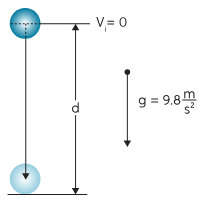Free Fall Calculator is a tool that calculates the ‘Velocity’ and ‘Time’ during the free fall condition of the object. Free fall refers to the motion of an object that is falling under the influence of gravity alone, without any other forces acting upon it. In a free fall scenario, the only force acting on the object is the force of gravity, which causes the object to accelerate downward. This concept is a fundamental principle in classical mechanics and is often used to study the motion of objects in the absence of air resistance or other external forces.
Free Fall Calculator
Key characteristics of free fall include:
- Acceleration Due to Gravity: In free fall, the object experiences a constant acceleration due to gravity. On Earth’s surface, the acceleration due to gravity is approximately \(9.8 \, \text{m/s}^2\), and it points downward toward the center of the Earth.
- Equal Acceleration: All objects in free fall, regardless of their mass, experience the same acceleration due to gravity. This is famously demonstrated by dropping a feather and a hammer on the Moon, where there is no significant air resistance.
- Increasing Velocity: As the object falls, its velocity increases over time. This is because the acceleration due to gravity causes the object to gain speed with each passing second.
- Negligible Air Resistance: Free fall assumes that air resistance or drag is negligible. In reality, air resistance can affect the motion of objects in free fall, especially at higher speeds.
- Vertical Motion: Free fall typically involves vertical motion, where the object is moving vertically downward. Horizontal motion (if present) is generally not affected by gravity alone.

Free fall is an essential concept in understanding various aspects of mechanics, such as projectile motion, gravitational acceleration, and the behavior of objects in different gravitational fields. It serves as a fundamental basis for analyzing motion under the influence of gravity and forms the foundation for more complex physics concepts.
Key formulas related to free fall:
- Velocity Formula: The velocity (\(v\)) of an object in free fall can be calculated using the formula:
\[ v = g \cdot t \]
- Time of Fall Formula: The time (\(t\)) it takes for an object to fall a certain distance in free fall can be calculated using the formula:
\[ t = \sqrt{\frac{2h}{g}} \]
These formulas assume that air resistance is negligible and that the object starts from rest. If the object has an initial velocity or if air resistance needs to be considered, more complex equations may be necessary.
It’s important to note that these formulas apply to situations where the object is dropped from a certain height and falls freely under the influence of gravity. If the object is projected upward or downward with an initial velocity, the equations will be different.
Thanks for reading the blog Free Fall Calculator.